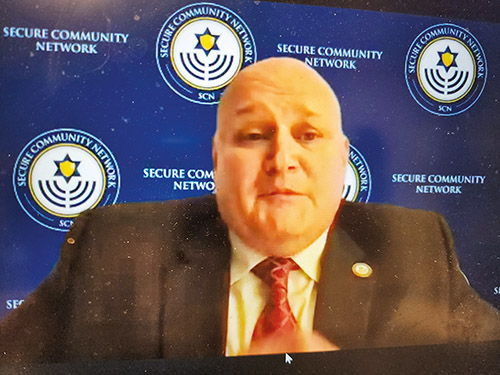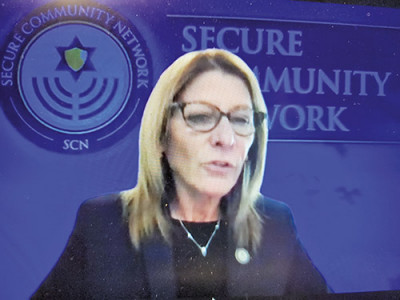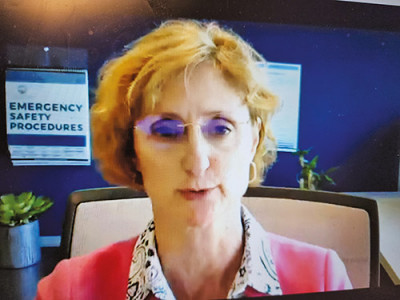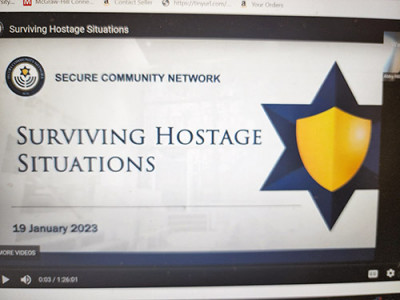
The Secure Community Network (SCN), in conjunction with the Jewish Federations of North America and the Conference of Presidents of Major American Jewish Organizations, held a webinar on January 19, “Surviving Hostage Situations,” detailing what to do (and what not to do) to increase people’s chances for survival. Only one year after four hostages escaped an 11-hour standoff at Congregation Beth Israel in Colleyville, Texas, the information presented was critical and timely as antisemitic attacks and incidents continue to increase in the United States and around the world. According to FBI data, Jews are the target of more than 60% of religiously motivated hate crimes despite comprising only 2% of the population.
Michael Masters, SCN national director and CEO, noted, “We cannot choose when and where security threats will appear,
but we can learn which proactive actions we can undertake to expand the shield of security and lessen the impact.” Masters emphasized that the hostages in Colleyville were not rescued, rather they were able to escape by using tools and techniques they had learned in a seminar presented by the local Jewish Federation.
Jeff Cohen, current president of Congregation Beth Israel, described using techniques learned in a training session. The standard mantra of “Run, hide, fight” does not necessarily fit in every circumstance or situation. The weather was unusually cold in Colleyville, and the congregation let a stranger into the building who claimed to be homeless, hungry and cold. The man did not appear to be a threat, so they ignored protocol. Stunned congregants viewing the service via webinar watched as the stranger turned the synagogue’s act of compassion into an active hostage situation. The hostages could not communicate with one another, but relied on their training to remain calm and position themselves near an exit. They made it a point to engage the attacker in a non-adversarial way and continually assess what materials they had around them could potentially be used as weapons. When the time was right, they were able to leave through a side door.

Shawn Brokos and Beth LaManna, retired FBI agents now working as security advisers for Jewish communities, used their experience as certified crisis negotiators to outline a set of tips for surviving a hostage situation. They stressed that training saves lives, increases the survival rate, and lessens the probability of post-traumatic stress on survivors.
While some of the tips could be perceived as “common sense” actions, when stress levels and anxiety rises, the obvious course is not as easy to implement. The first lesson is to identify a true hostage situation versus a non-hostage situation. In the former, an action is taken against someone in a workplace or domestic situation. The situation is emotionally driven, with the hostage taker already having “what they want” and lacking a bargaining chip for negotiations. Situations like Colleyville often have better outcomes as the hostage taker has more substantive demands that can be negotiated for the return of hostages. An FBI database notes that approximately 97% of situations belong in this category.
The first 15 to 45 minutes of a situation are the most dangerous due to the level of panic and confusion experienced by the victims as well as the perpetrators. The best action to mitigate the threat and increase the odds of survival is to remain calm, and encourage others to do the same. Deep breathing increases the oxygen level and increases the ability for good decision making. “Calm is contagious”—the sooner the emotional levels are reduced, the sooner the resolution can occur.
While you may be vehemently opposed to the positions stated by the attacker, be compliant and respectful. Develop the survival mindset of “blending into the sidelines.” Avoid trying to be a hero or antagonizing the attacker; the situation may last longer than you think, and calming the ambient anxiety will increase your chances of survival. Your goal is to slow things down and buy time. Humanize yourself to the hostage taker and treat them like a human. Seek the commonality by finding ways to connect, while avoiding barbs that might antagonize. Active listening skills are recommended to connect to the hostage taker. “The more time they spend talking, the less time they have to hurt someone.”

One of the best things you can do is to be aware of what is occurring. Take specific note of what the attacker looks like, what they are wearing, what they say, and what weapons they have. Identify where people are in the building and any escape routes as well as the location of items to use as potential weapons to save your life—only if you are in imminent danger. If you are released or escape, your observations will serve as eyes and ears for the rescue team.
If you are able to escape, keep your hands empty and away from your body. Law enforcement personnel do not know who the hostage or criminal is. With only a split second to make that determination, you don’t want to be shot by mistake by appearing to conceal a possible weapon.
Despite wanting to be cooperative, it is not a good idea to speak to news networks until after the entire situation has been resolved. Broadcasts on network news that find their way to the hostage taker can remove elements of surprise and jeopardize the remaining hostages.
Cohen added that he would hate to see the Jewish community lose their ability to help their fellow man. In retrospect, they could have allowed the man in the building but required that he leave the backpack (that contained his weapons) outside or called social services to assist. In actuality, one never knows when or where a threat will occur. It is best to have training and practice the skills in order to be prepared.

SCN serves as the central organization dedicated exclusively to the safety and security of the American Jewish community by providing timely, credible threat and incident information to both law enforcement and community partners. They develop and implement strategic frameworks that enhance the safety and security of the Jewish people, developing best-practice policies and procedures, undertaking threat and vulnerability assessments, coordinating training and education, offering consultation on safety and security matters and providing crisis management support during critical incidents. An extensive library of webinars and other information is available on their web site https://www.securecommunitynetwork.org/
By Deborah Melman











